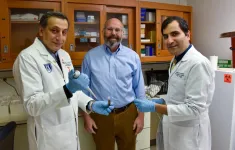(Press-News.org) A two-week course of high doses of CBD helps restore the function of two proteins key to reducing the accumulation of beta-amyloid plaque, a hallmark of Alzheimer's disease, and improves cognition in an experimental model of early onset familial Alzheimer's, investigators report.
The proteins TREM2 and IL-33 are important to the ability of the brain's immune cells to literally consume dead cells and other debris like the beta-amyloid plaque that piles up in patients' brains, and levels of both are decreased in Alzheimer's.
The investigators report for the first time that CBD normalizes levels and function, improving cognition as it also reduces levels of the immune protein IL-6, which is associated with the high inflammation levels found in Alzheimer's, says Dr. Babak Baban, immunologist and associate dean for research in the Dental College of Georgia and the study's corresponding author.
There is a dire need for novel therapies to improve outcomes for patients with this condition, which is considered one of the fastest-growing health threats in the United States, DCG and Medical College of Georgia investigators write in the Journal of Alzheimer's Disease.
"Right now we have two classes of drugs to treat Alzheimer's," says Dr. John Morgan, neurologist and director of the Movement and Memory Disorder Programs in the MCG Department of Neurology. One class increases levels of the neurotransmitter acetylcholine, which also are decreased in Alzheimer's, and another works through the NMDA receptors involved in communication between neurons and important to memory. "But we have nothing that gets to the pathophysiology of the disease," says Morgan, a study coauthor.
The DCG and MCG investigators decided to look at CBD's ability to address some of the key brain systems that go awry in Alzheimer's.
They found CBD appears to normalize levels of IL-33, a protein whose highest expression in humans is normally in the brain, where it helps sound the alarm that there is an invader like the beta-amyloid accumulation. There is emerging evidence of its role as a regulatory protein as well, whose function of either turning up or down the immune response depends on the environment, Baban says. In Alzheimer's, that includes turning down inflammation and trying to restore balance to the immune system, he says.
That up and down expression in health and disease could make IL-33 both a good biomarker and treatment target for disease, the investigators say.
CBD also improved expression of triggering receptor expressed on myeloid cells 2, or TREM2, which is found on the cell surface where it combines with another protein to transmit signals that activate cells, including immune cells. In the brain, its expression is on the microglial cells, a special population of immune cells found only in the brain where they are key to eliminating invaders like a virus and irrevocably damaged neurons.
Low levels of TREM2 and rare variations in TREM2 are associated with Alzheimer's, and in their mouse model TREM2 and IL-33 were both low.
Both are essential to a natural, ongoing housekeeping process in the brain called phagocytosis, in which microglial cells regularly consume beta amyloid, which is regularly produced in the brain, the result of the breakdown of amyloid-beta precursor protein, which is important to the synapses, or connection points, between neurons, and which the plaque interrupts.
They found CBD treatment increased levels of IL-33 and TREM2 -- sevenfold and tenfold respectively.
CBD's impact on brain function in the mouse model of early onset Alzheimer's was assessed by methods like the ability to differentiate between a familiar item and a new one, as well as observing the rodents' movement.
People with Alzheimer's may experience movement problems like stiffness and an impaired gait, says Dr. Hesam Khodadadi, a graduate student working in Baban's lab. Mice with the disease run in an endless tight circle, behavior which stopped with CBD treatment, says Khodadadi, the study's first author.
Next steps include determining optimal doses and giving CBD earlier in the disease process. The compound was given in the late stages for the published study, and now the investigators are using it at the first signs of cognitive decline, Khodadadi says. They also are exploring delivery systems including the use of an inhaler that should help deliver the CBD more directly to the brain. For the published studies, CBD was put into the belly of the mice every other day for two weeks.
A company has developed both animal and human inhalers for the investigators who also have been exploring CBD's effect on adult respiratory distress syndrome, or ARDS, a buildup of fluid in the lungs that is a major and deadly complication of COVID-19, as well as other serious illnesses like sepsis and major trauma. The CBD doses used for the Alzheimer's study were the same the investigators successfully used to reduce the "cytokine storm" of ARDS, which can irrevocably damage the lungs.
Familial disease is an inherited version of Alzheimer's in which symptoms typically surface in the 30s and 40s and occurs in about 10-15% of patients.
CBD should be at least equally effective in the more common, nonfamilial type Alzheimer's, which likely have more targets for CBD, Baban notes. They already are looking at its potential in a model of this more common type and moving forward to establish a clinical trial.
Plaques as well as neurofibrillary tangles, a collection of the protein tau inside neurons, are the main components of Alzheimer's, Morgan says. Beta-amyloid generally appears in the brain 15-20 years or more before dementia, he says, and the appearance of tau tangles, which can occur up to 10 years afterward, correlates with the onset of dementia. There is some interplay between beta amyloid and tau that decrease the dysfunction of each, Morgan notes.
The Food and Drug Administration is scheduled to make a ruling by early June on a new drug aducanumab, which would be the first to attack and help clear beta amyloid, Morgan says.
INFORMATION:
Other coauthors include Drs. David Hess, neurologist and MCG dean, and MCG neuroscientists Kumar Vaibhav and Krishnan Dhandapani. The research was supported by the National Institutes of Health.
Read the full study.
An analysis of SARS-CoV-2 genome diversity in more than 1,000 people in the United Kingdom suggests that if viral mutations do arise, they can be transmitted in some cases but they rarely persist in subsequent transmissions. "Our observations indicate the within-host emergence of vaccine- and therapeutic-escape mutations is likely to be relatively rare," say the authors, "at least during early infection when viral loads are high." However, because mutations that can escape therapies like antibodies were identified, including in higher viral load samples, the authors encourage continued monitoring and vigilance, particularly as vaccines and therapeutics that put "pressure" on viruses to adapt are rolled out more widely. ...
While receiving just one dose of a two-dose SARS-CoV-2 vaccine tends to decrease infections in the short-term if it produces a strong immune response, it may increase the potential for the virus to "escape" therapies in the longer-term if one-dose vaccinal immunity is weak, reports a new modeling study "[O]ur work emphasizes that the impact of vaccine dosing regimes are strongly dependent on the relative robustness of immunity conferred by a single dose," the authors write. As COVID-19 vaccines have been distributed internationally, several countries including the United Kingdom and Canada have chosen to delay the second dose to increase the number of individuals ...
Amid the COVID-19 pandemic, children's hospitals across the United States have seen signification reductions in the number of children being treated for common pediatric illnesses like asthma and pneumonia, according to a new multicenter study led by Monroe Carell Jr. Children's Hospital at Vanderbilt.
Researchers at Children's Hospital found that 42% fewer children were being seen and hospitalized at 44 children's hospital across the U.S. for both respiratory and non-respiratory illnesses, with the most significant reduction seen in children under age 12. Hospitals saw a decline in the number of children seen or hospitalized for respiratory illness by 62%, while there was 38% reduction for non-respiratory illnesses.
The trend, ...
University of Arizona researcher Jekan Thanga is taking scientific inspiration from an unlikely source: the biblical tale of Noah's Ark. Rather than two of every animal, however, his solar-powered ark on the moon would store cryogenically frozen seed, spore, sperm and egg samples from 6.7 million Earth species.
Thanga and a group of his undergraduate and graduate students outline the lunar ark concept, which they call a "modern global insurance policy," in a paper presented over the weekend during the IEEE Aerospace Conference.
"Earth is naturally a volatile environment," said Thanga, a professor of aerospace and mechanical engineering in the UArizona College ...
Neuroendocrine tumours are cancers that begin in specialised cells called neuroendocrine cells. These cells have traits similar to those of nerve cells and hormone-producing cells. Neuroendocrine tumours, while rare, can occur anywhere in the body. Most affect the cardiothoracic region, eg lungs, appendix, small intestine, pancreas as well as the rectum. There are many types of neuroendocrine tumours: some grow slowly while others develop very rapidly.
Neuroendocrine tumors are characterised by abundant production of somatostatin receptor 2, a naturally circulating hormone that is an important target for scientists studying new treatment approaches.
Peptide Receptor Radionuclide Therapy (PRRT) is the most commonly used treatment for refractive ...
Home delivery of HIV medicines in South Africa significantly increased viral suppression compared to those who received clinical care, according to a study by researchers at the University of Washington School of Medicine.
The study, conducted with Amazon.com guidance during COVID-19 restrictions in South Africa, showed that among study participants, paying a fee for home delivery and monitoring of antiretroviral therapy (ART) was highly acceptable in the context of low income and high unemployment, and improved health outcomes as a result.
The researching findings were ...
Researchers at the Buck Institute analyzed data from the COVID-19 Symptom Tracker app used by 3 million people in the United Kingdom, adding the use of immunosuppressant medication, use of a mobility aid, shortness of breath, fever, and fatigue to the list of symptoms and comorbidities that increase the risk for severe COVID-19. Results are published in the Journal of Medical Internet Research.
"Even though there are established risk factors for severe COVID-19 there are no good predictors that enable healthcare providers, or even those who have tested positive, to assess who should seek advanced medical care," says Buck Institute ...
TAMPA, Fla. (March 8, 2021) -- Preterm birth is a END ...
Recently, Prof. CHEN Gao from Institute of Geometry and Physics of the University of Science and Technology of China has made breakthrough in the field of complex differential geometry. Using mathematical invention, he buildt a new bridge between the relativity of Einstein and quantum mechanics. This work was published in Inventiones Mathematicae.
In the field of complex differential geometry, there are two crucial physical equations: the Hermitian-Yang-Mills equation, which became the standard model of quantum mechanics, and the Kähler-Einstein equation, which is closely related to relativity. To stably solve these two equations ...
A team of researchers led by Professor Yaakov Nahmias, director of the Grass Center for Bioengineering at the Hebrew University of Jerusalem and founder of Tissue Dynamic, introduced a new technological approach that has the potential to rapidly develop new drugs without the need for animal experiments.
According to Professor Nahmias, "Drug development is a long and expensive endeavor that is defined by multiple failures. The main reason for this failure is that clinical experiments are ultimately based on minimal information gained from animal experiment which often fail to replicate the human response."
The primary animals used in drug development ...



